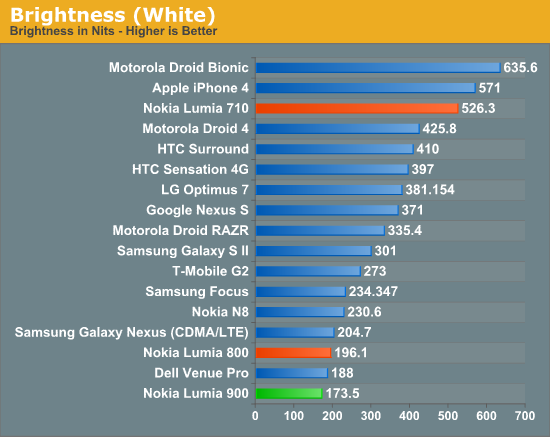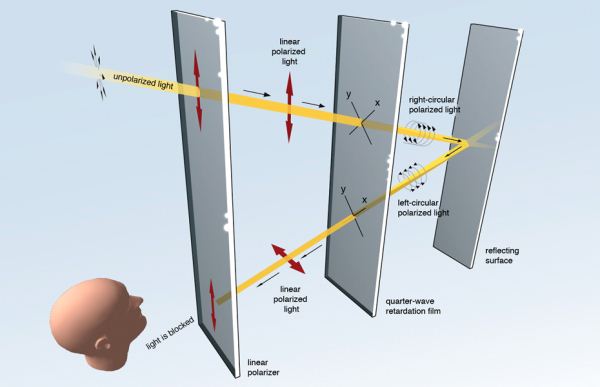Nokia Lumia 900 Review - Windows Phone with LTE
by Brian Klug on April 3, 2012 9:00 PM ESTDisplay Quality
Like the Lumia 800, the Lumia 900 uses an AMOLED display instead of an LCD. One of the chief differentiators between the two models however is the difference in subpixel rendering. Whereas the Lumia 800 used a 3.7“ PenTile RGBG SAMOLED panel, the Lumia 900 uses a 4.3” SAMOLED+ panel with an RGB subpixel stripe. Those names fit, that is, if we’re following Samsung’s naming scheme, and as an aside this is undoubtedly a Samsung panel.
The effective resolution of both displays are 800x480 WVGA, like all Windows Phones, however. Jumping up in display size pretty much necessitates that change to RGB, since PenTile really only works when subpixels are below human visual acuity. In addition, we’ve already seen 4.3" SAMOLED+ WVGA displays out of Samsung (see the Focus S).
I measured the Lumia 900 display using an i1D2 just like I’ve done with numerous other smartphones, though at this point the advanced color and gamut information will have to wait until I make some targets. Again, because AMOLED is emissive, black color pixels are literally off, so contrast graphs are omitted. The Lumia 900 doesn’t go super bright, like other AMOLEDs I’ve seen. In fact, it’s slightly dimmer than the Lumia 800’s maximum of 196 nits. Remember that going to a larger display, especially AMOLED due to its emissive nature, increases power demands as r^2 since we’re talking about areal size.
| Lumia 900 Display Metrics | |||
| Brightness Level | Black Brightness (nits) | White Brightness (nits) | White Point (K) |
| Low | 0 | 72.68 | 6635 |
| Medium | 0 | 140.06 | 6930 |
| High | 0 | 173.55 | 6812 |
Nokia was able to get the Lumia 900 display nice and close to 6500K, which is interesting considering how many other AMOLED displays I’ve seen which are up near 8000K or higher and noticeably blue all the time.

I glossed over ClearBlack on the previous Lumia reviews partly due to time constraints, partly due to not knowing the exact details of their optical path. That said, it was immediately obvious that the system used circular polarization’s behavior upon reflection to attenuate back reflections. However, since writing those reviews, Nokia has outlined their optical system in a conversations post, and the long and short of it is that the system consists of a linear polarizer and quarter-wave plate.
Incoming diffuse light gets vertically polarized by a surface polarizer, which becomes right hand circularly polarized when passing through the quarter wave plate. When circular polarized reflects off of a surface, it changes handedness - in this case from right to left handed circular. Upon passing through the quarter wave plate on its way out, this becomes horizontally polarized, which is then strongly attenuated by the surface polarizer with its fast axis aligned vertically on its way out, which acts like an analyzer. The end result is that outdoors the only reflection you’ll get is from the first surface, not the surface of the display itself, which does reduce resulting glare.
This change also permits the Lumia 900 to still look bright outside, and in turn allows Nokia to run the display at a lower brightness and save some amount of power. For a while I was waiting for some OEM to introduce a system using polarization to diminish back reflections, and Nokia has done it with ClearBlack.
Indoor viewing angles for the Lumia 900 are excellent as evidenced by the purple test pattern from WP Bench not changing color at extreme field angles. In addition, I subjectively can’t find any issues with the display - there are none of the other problems that affect the higher dot pitch AMOLEDs such as grain or mura. Outdoor viewing angles are likewise good for the Lumia 900 in part thanks to ClearBlack.

















128 Comments
View All Comments
Beerfloat - Thursday, April 5, 2012 - link
Yup, I guess there's always a next best thing around the corner in the tech industry. Krait is pretty cool. But then, A15 bundled with a fast SGX or Mali GPU will be cooler still. Tegra 3 does have the benefit of the low power 5th core, plus, for right or for wrong, Nvidia always seems to bring the little extra member benefits.tipoo - Thursday, April 5, 2012 - link
True, but the Krait version of the One X isn't that far away, compared to A15 and all that. The Krait One S is already shipping. And Nvidia's fifth core doesn't help it against Kraits battery life, look at the One S with Krait, it gets significantly higher life (to be fair, some will be the screen, but still). Tegra Zone optimizations apart, Krait is nearly uniformly better.jed22281 - Sunday, April 8, 2012 - link
typical moronic response.ecuador - Wednesday, April 4, 2012 - link
If more people got their hands on the N9's it would not be a dead OS. Even people with the latest iphones are amazed when they try out the N9, something I have never seen with, say, an Android phone.That's why I complain about tech sites not trying to give the N9 the chance that Nokia did not want it to have - it is (was?) by far the most promising mobile OS (not to mention the most open).
jed22281 - Sunday, April 8, 2012 - link
Maemo6x (meego-harmattan) used by the N9 is far from being the most open.Tizen & WebOS are far more open, even Android is arguably....
If it had been given time to evolve into real MeeGo* it would've been w/o question.
There's MeeGo derivatives floating about still (MeR + Nemo/Plasma etc)
But they're more underdeveloped than they would've been, had resources not been dropped hugely in the past 14mth.
*which would've completed by July 12' at the latest w/the 1st x86 phone, after the 3rd Harmattan ph started reaching shelves.
jed22281 - Sunday, April 8, 2012 - link
typical moronic response.Tujan - Wednesday, April 4, 2012 - link
Excellent article about a cell phone from anandtech.com !...
With the exception of memory bandwidth this is certainly a great little computer radio phone.
....
"Waiting is never easy" <- catchy. !
Origin32 - Wednesday, April 4, 2012 - link
And of course half of the comments are about Android phones being slow. Yes, the UI is less smooth than iOS of WP. But I really don't care about that and I can't be the only one. In my humble opinion functionality is king, and whether my homescreen renders at 20fps or 60 doesn't really matter. Android has some great features that I am yet to see in iOS or WP. Having borrowed an iPhone for a couple hours I already found it to be incredibly constraining and the lack of a back or menu button annoyed the crap out of me. As for WP, I played around with a Lumia 800 for a while but all the sidescrolling in the homescreen and in apps was very confusing. It made the display feel too narrow.Plus, I bet you'll all be glad we have quadcore smartphones when they've become so fast you can ditch your laptop, but of course most of you never even considered that :)
valhar2000 - Wednesday, April 4, 2012 - link
People around here keep talking about the superior feature set of Android. What are these features that other phone OSs don't have?Beerfloat - Wednesday, April 4, 2012 - link
Well, HD screens for one. Grown up DPI-independent rendering for another. A choice of different form factor devices to suit various usage patterns and budgets. Multiple software stores, an enormous amount of apps, close integration with Google services (if so desired), wonderful customizability, the most straightforward interaction with other devices like PCs (it's just an USB disk drive, plus it talks CIFS).But oh well.